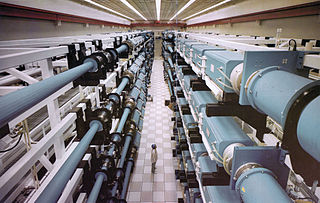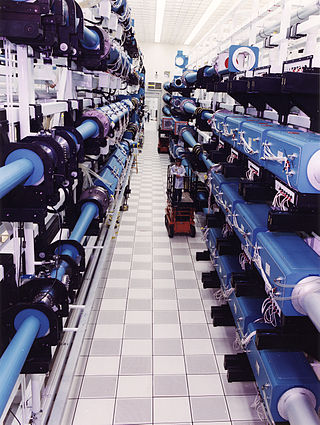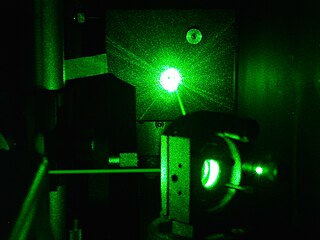
Inertial confinement fusion (ICF) is a fusion energy process that initiates nuclear fusion reactions by compressing and heating targets filled with thermonuclear fuel. In modern machines, the targets are small spherical pellets about the size of a pinhead typically containing a mixture of about 10 milligrams of deuterium 2H and tritium 3H.
This timeline of nuclear fusion is an incomplete chronological summary of significant events in the study and use of nuclear fusion.

The National Ignition Facility (NIF) is a laser-based inertial confinement fusion (ICF) research device, located at Lawrence Livermore National Laboratory in Livermore, California, United States. NIF's mission is to achieve fusion ignition with high energy gain. It achieved the first scientific breakeven controlled fusion experiment on December 5, 2022, with an energy gain of 1.5 megajoules. It supports nuclear weapon maintenance and design by studying the behavior of matter under the conditions found within nuclear explosions.

A krypton fluoride laser is a particular type of excimer laser, which is sometimes called an exciplex laser. With its 248 nanometer wavelength, it is a deep ultraviolet laser which is commonly used in the production of semiconductor integrated circuits, industrial micromachining, and scientific research. The term excimer is short for 'excited dimer', while exciplex is short for 'excited complex'. An excimer laser typically contains a mixture of: a noble gas such as argon, krypton, or xenon; and a halogen gas such as fluorine or chlorine. Under suitably intense conditions of electromagnetic stimulation and pressure, the mixture emits a beam of coherent stimulated radiation as laser light in the ultraviolet range.

Nova was a high-power laser built at the Lawrence Livermore National Laboratory (LLNL) in California, United States, in 1984 which conducted advanced inertial confinement fusion (ICF) experiments until its dismantling in 1999. Nova was the first ICF experiment built with the intention of reaching "ignition", a chain reaction of nuclear fusion that releases a large amount of energy. Although Nova failed in this goal, the data it generated clearly defined the problem as being mostly a result of Rayleigh–Taylor instability, leading to the design of the National Ignition Facility, Nova's successor. Nova also generated considerable amounts of data on high-density matter physics, regardless of the lack of ignition, which is useful both in fusion power and nuclear weapons research.
An optical frequency multiplier is a nonlinear optical device in which photons interacting with a nonlinear material are effectively "combined" to form new photons with greater energy, and thus higher frequency. Two types of devices are currently common: frequency doublers, often based on lithium niobate (LN), lithium tantalate (LT), potassium titanyl phosphate (KTP) or lithium triborate (LBO), and frequency triplers typically made of potassium dihydrogen phosphate (KDP). Both are widely used in optical experiments that use lasers as a light source.

Inertial Fusion Energy is a proposed approach to building a nuclear fusion power plant based on performing inertial confinement fusion at industrial scale. This approach to fusion power is still in a research phase. ICF first developed shortly after the development of the laser in 1960, but was a classified US research program during its earliest years. In 1972, John Nuckolls wrote a paper predicting that compressing a target could create conditions where fusion reactions are chained together, a process known as fusion ignition or a burning plasma. On August 8, 2021, the NIF at Livermore National Laboratory became the first ICF facility in the world to demonstrate this. This breakthrough drove the US Department of Energy to create an Inertial Fusion Energy program in 2022 with a budget of 3 million dollars in its first year.
Laser Mégajoule (LMJ) is a large laser-based inertial confinement fusion (ICF) research device near Bordeaux, France, built by the French nuclear science directorate, Commissariat à l'Énergie Atomique (CEA).

Argus was a two-beam high power infrared neodymium doped silica glass laser with a 20 cm (7.9 in) output aperture built at Lawrence Livermore National Laboratory in 1976 for the study of inertial confinement fusion. Argus advanced the study of laser-target interaction and paved the way for the construction of its successor, the 20 beam Shiva laser.

Cyclops was a high-power laser built at the Lawrence Livermore National Laboratory (LLNL) in 1975. It was the second laser constructed in the lab's Laser program, which aimed to study inertial confinement fusion (ICF).
The Gekko XII Laser (激光XII号レーザー) is a high-power, 12-beam, neodymium-doped glass laser at the Osaka University's Institute for Laser Engineering (大阪大学レーザーエネルギー学研究センター) completed in 1983, which is used for high energy density physics and inertial confinement fusion research. The name refers to the twelve individual beamlines used to amplify the laser energy.

The High Power laser Energy Research facility (HiPER), is a proposed experimental laser-driven inertial confinement fusion (ICF) device undergoing preliminary design for possible construction in the European Union. As of 2019, the effort appears to be inactive.

The Vulcan laser is an infrared, 8-beam, petawatt neodymium glass laser at the Rutherford Appleton Laboratory's Central Laser Facility in Oxfordshire, United Kingdom. It was the facility's first operational laser.
Magnetized Target Fusion (MTF) is a fusion power concept that combines features of magnetic confinement fusion (MCF) and inertial confinement fusion (ICF). Like the magnetic approach, the fusion fuel is confined at lower density by magnetic fields while it is heated into a plasma. As with the inertial approach, fusion is initiated by rapidly squeezing the target to greatly increase fuel density and temperature. Although the resulting density is far lower than in ICF, it is thought that the combination of longer confinement times and better heat retention will let MTF operate, yet be easier to build. The term magneto-inertial fusion (MIF) is similar, but encompasses a wider variety of arrangements. The two terms are often applied interchangeably to experiments.
Fusion ignition is the point at which a nuclear fusion reaction becomes self-sustaining. This occurs when the energy being given off by the reaction heats the fuel mass more rapidly than it cools. In other words, fusion ignition is the point at which the increasing self-heating of the nuclear fusion removes the need for external heating. This is measured by the fusion energy gain factor. At this point, the external energy used to heat the fuel to fusion temperatures is no longer needed.
LASNEX is a computer program that simulates the interactions between x-rays and a plasma, along with many effects associated with these interactions. The program is used to predict the performance of inertial confinement fusion (ICF) devices such as the Nova laser or proposed particle beam "drivers". Versions of LASNEX have been used since the late 1960s or early 1970s, and the program has been constantly updated. LASNEX's existence was mentioned in John Nuckolls' seminal paper in Nature in 1972 that first widely introduced the ICF concept, saying it was "...like breaking an enemy code. It tells you how many divisions to bring to bear on a problem."

LIFE, short for Laser Inertial Fusion Energy, was a fusion energy effort run at Lawrence Livermore National Laboratory between 2008 and 2013. LIFE aimed to develop the technologies necessary to convert the laser-driven inertial confinement fusion concept being developed in the National Ignition Facility (NIF) into a practical commercial power plant, a concept known generally as inertial fusion energy (IFE). LIFE used the same basic concepts as NIF, but aimed to lower costs using mass-produced fuel elements, simplified maintenance, and diode lasers with higher electrical efficiency.
Heavy ion fusion is a fusion energy concept that uses a stream of high-energy ions from a particle accelerator to rapidly heat and compress a small pellet of fusion fuel. It is a subclass of the larger inertial confinement fusion (ICF) approach, replacing the more typical laser systems with an accelerator.
The history of nuclear fusion began early in the 20th century as an inquiry into how stars powered themselves and expanded to incorporate a broad inquiry into the nature of matter and energy, as potential applications expanded to include warfare, energy production and rocket propulsion.
Andrea "Annie" Kritcher is an American nuclear engineer and physicist who works at the Lawrence Livermore National Laboratory. She was responsible for the development of Hybrid-E, a capsule that enables inertial confinement fusion. She was elected Fellow of the American Physical Society in 2022.












